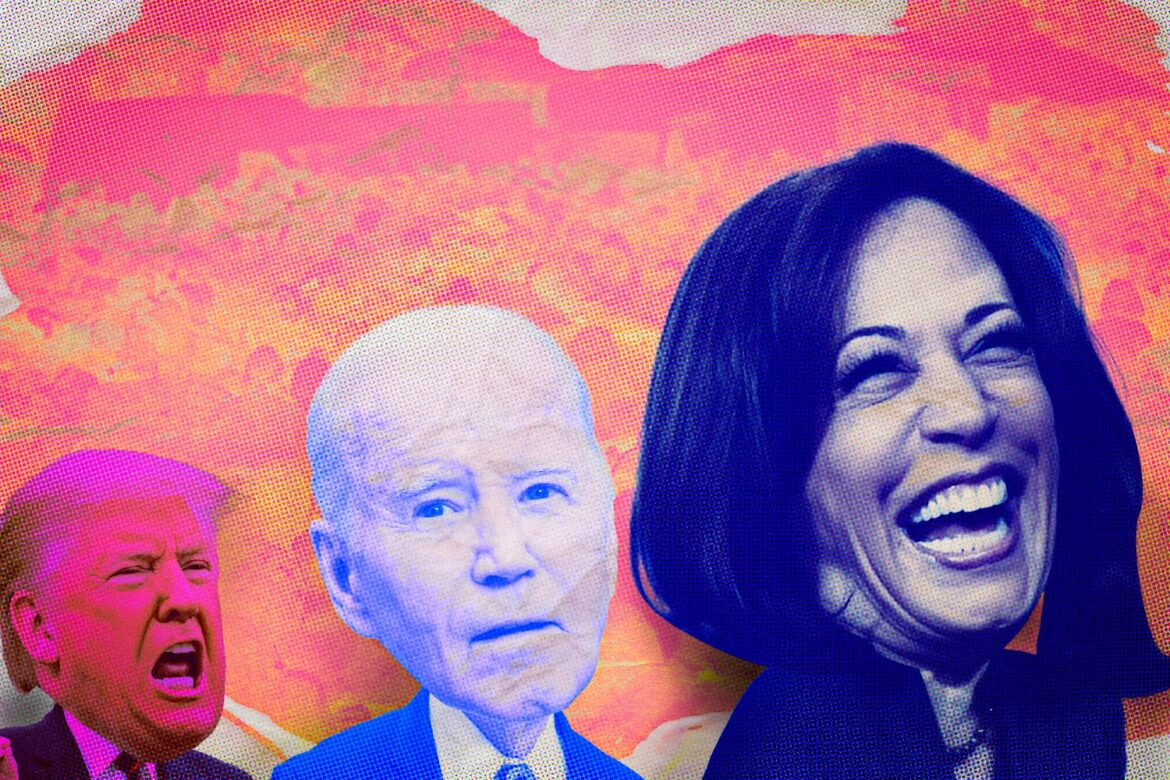Graphic by Sophie Jesson-Ward
In her bid for the Oval Office, Vice President Kamala Harris has attempted to connect with voters in several ways, sometimes contradicting herself. Her campaign has been tasked with juggling an assortment of goals that aren’t very cohesive: trying to turn out progressives, appeal to centrists and lambast her opponent, former President Donald Trump, all while keeping a healthy distance from the Biden presidency. This balancing act has proved tricky, as she claims to be a new beacon for liberal ideals but often grounds herself in a more middle-of-the-road approach. This isn’t necessarily a bad thing – as campaigning has devolved into a deluge of information bombardment and message control – it just aptly captures the marked shift in political stratagem within the past decade.
Much of the presidential race thus far has been anchored to Trumpism: a vote for the former president affirms the combative ideology he champions. In response, Harris has worked relentlessly to present her potential presidency as a step in a new direction, away from the Biden administration and even farther from anything resembling Trump. This posturing has manifested itself in her campaign slogan, “A New Way Forward.”
But does Harris actually offer voters an opportunity for significant change? Is her messaging a genuine call to turn the page in this current political climate of discontent? Or is it merely campaign rhetoric designed to maximize voter turnout and push the right buttons for undecided Americans?
Harris has intentionally kept the scope of what her presidency may look like narrow. When discussing her platform, she has focused on what most voters primarily care about – the economy. In her opening statement of the only presidential debate this election cycle, Harris highlighted her plan of “lifting up the middle class and working people of America.” She promised to lower inflation, create more affordable housing and establish an opportunity economy that would work for all Americans.
Promises to strengthen the economy by making it more accessible and equitable for the American people are encouraging, but they do not precisely spell out how different this would be from any other democratic presidency in the last 30 years. Harris wants to differentiate herself from sitting President Joe Biden, as it has been reported that her campaign has been trying to keep Biden and his approval rating of 37% at arm’s length. What isn’t clear is how exactly Harris plans to separate herself. While she has raised some forward-thinking policy ideas, like a federal ban on price gouging, she also has stated that she would not have done much differently than Biden in the past four years.
Due to the unique situation in which Biden stepped down from a possible reelection bid with less than 4 months left before the election, Harris was able to ascend to the top of the Democratic ticket without having to battle any of her constituents. Primaries are a vital component of American democracy, where, in our two-party system, most people vote along party lines. Having dodged this process, Harris never had to articulate specific policies, nor did she have to appeal to more progressive liberals.
The 2020 Democratic Party presidential primary was — at least initially — a strong example of how a competitive primary can provide voters with a diverse multitude of options regarding both candidates and policies. It served as a refreshing referendum on the party as the voter base was able to rally around specific progressive platforms they believed in. In a deep field, candidates were forced to flesh out their ideas to stand out amongst their peers.
In this 2020 contest, before joining Biden’s ticket as vice president, Harris was among the contenders and attempted to garner support by appealing to the far left. She advocated for eliminating private health insurance, banning fracking and cutting back on Immigration and Customs Enforcement. Harris has consistently backtracked on these stances in the four years since then, pivoting back to a more centrist position, similar to Biden. This ideological malleability Harris has shown is the key to her current strategy – where resonating with voters is paramount, and the substance behind her policies is secondary.
Without having to compete against any democratic challengers in a primary, Harris avoided debates that would require more nuance and specificity. The Israel-Palestine conflict, border security, environmental regulations — many issues split the Democratic party, and Harris was able to escape any costly entanglement in them.
While a lack of a primary has set the stage for Harris’s open-ended approach, the simple fact that her opponent is Trump has motivated much of her political framework. Ever since the 2016 election, American politics has been tied to Trump. For many conservatives, he offers a vitriolic rebuke of the traditional political establishment. For many liberals, he poses an immediate and dangerous threat to the very nature of our democracy. Trump’s presence in the political landscape is consuming; he has transformed into a larger-than-life figure transcending conventional political discussion.
There is no point in debating actual, meaningful policy because Trump and his platform completely lack substance. During the debate, when pressed by the moderator for the details of his healthcare plan, he brushed it aside and said he had “concepts of a plan.” His candidacy is built upon a cultural foundation, not one of deliberate political activity. Trump’s plan of action is to fearmonger about rampant crime and out-of-control illegal immigration — regardless of whether or not any of it is true — to cast the U.S. as a failing state on the precipice of calamity.
So, Harris has decided to paint herself as the antithesis of Trump. Trump has become a boogeyman in the political sphere for Democrats, and, just as Biden did four years ago, Harris is attempting to appeal to middle-of-the-line voters to thwart him. This makes her political posturing fascinatingly paradoxical: She’s trying to thread the needle of being appealingly moderate for undecided voters yet somehow separate from Biden’s decidedly center-left tenure in office, which has left many Americans unimpressed.
It seems that this political framing is — at least partially — a result of social media’s ever-increasing popularity. According to a survey conducted by the Pew Research Center, for the first time, more than half of American adults say they get their news at least sometimes, if not often, from social media. As more potential voters engage with news content on outlets like Facebook, TikTok and X, political candidates seem to be shifting their voter outreach strategies. There is a definite focus on narrative construction, headline-grabbing and engagement farming.
The meat and bones of traditional American political discourse are falling by the wayside. Where there used to be a productive back-and-forth and search for common ground, there is now an inflexible and relentless us-versus-them mentality. This current political reality fosters an unhealthy dynamic of divisive language and the constant manufacturing of ideological narratives – fueling the extensive polarization of the American electorate. Social media has opened a space for political candidates like Harris to implement elaborate campaigns tailored to various, often conflicting, voter groups.
Harris says she is blazing a new path forward but offers little evidence that this is actually true. Regardless, all that matters most, really, is that she is not Trump — or Biden. According to her, she’s on one side, and the bad guys are on the other. The hope is that on election day, enough Americans, with no appetite for another Trump presidency and no other alternatives, will vote for the candidate who just promises to be different — even if that may not be entirely accurate.




Comments are closed.